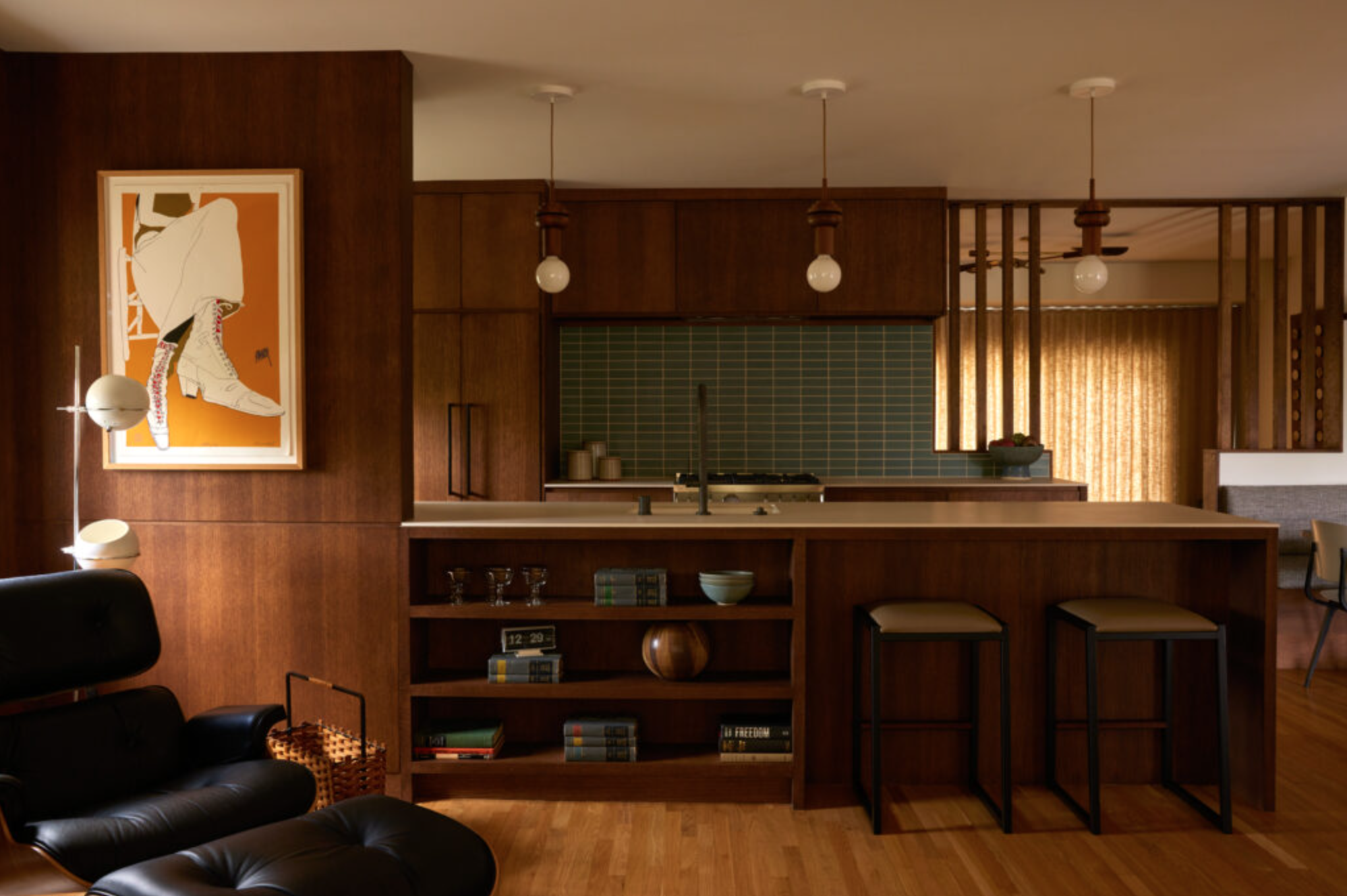Revival of Retro Kitchens
The kitchen is known to be the heart of the home. Today we are seeing many designers revive retro trends from the 60s and 70s. Both eras offer unique design elements that combine functionality with personality. Today we are diving into timeless kitchen designs that are the perfect inspiration for anyone looking to infuse their space with retro charm.
Round Kitchens
When looking at these stunning spaces, it really makes you wonder why more people don’t consider a round kitchen layout. Very similar to a conversation pit, it encourages guests and family to gather around, engage in discussions and possibly make a team effort to cook a delicious meal. Below is a kitchen in the Fred Antelline residence, designed by his son, Jon Antelline in 1961 next to the re-designed A. Quincy Jones Residence by Studio Shamshiri. Both interiors share similar design elements including the narrow vertical wood panelling, the stove placed in the center island and the round drop down hood.
Located in Rancho Santa Fe, California. The Fred Antelline residence, designed by his son, Jon Antelline in 1961. Photo by Julius Shulman © Paul Getty Trust, Getty Research Institute, Los Angeles (2004.R.10)
Detail of the curving walnut cabinetry and doors in the new kitchen. Photography by Stephen Kent Johnson.
The entirely reimagined kitchen is a tour de force of design and engineering, articulated in American black walnut with pale stone counters. Photography by Stephen Kent Johnson.
More Round Kitchens
Mid-Century Revival
When thinking of mid-century, you may think of the TV show, Mad Men. That’s exactly what the owners were going for when looking to bring life back to their 1950s home in Portland. Envision clean lines, warm wood tones, and moody lighting that would invite guests to stay awhile.
A revived 1950s kitchen in a Portland home. Project by Patrick Maziarski, principal designer and founder of Counsel Design Group.
Photo by Yoshihiro Makino
A revived 1950s kitchen in a Portland home. Project by Patrick Maziarski, principal designer and founder of Counsel Design Group.
Photo by Yoshihiro Makino
Key features of mid-century kitchens are sleek and simple cabinetry, natural wood tones, a touch of color often seen in backsplashes, walls or decor, built-in units, laminate countertops, tiled or laminate backsplashes (some geometric designs), modernist pendant lighting, dome shaped fixtures or recessed lighting.
Warsaw apartment, a renovation project with a great mid-century flavor by @hauslab_grzegorz_pniok
The Hattenbach House by architect Ray Kappe, aka the Sultan-Price House, Santa Monica, California, 1976
Photo by © Julius Shulman
Why Mid-Century Kitchens Still Inspire Today
Mid-century kitchens beautifully blend form and function, offering a timeless aesthetic that feels both nostalgic and modern. Their use of bold colors, clean lines, and smart layouts make them a favorite for retro enthusiasts and contemporary designers alike. Whether you're restoring an original kitchen or designing a new one, the mid-century style is a perfect blend of charm and practicality.
Bring The Outdoors In
Solariums in kitchens, began gaining popularity in the mid-20th century, particularly in the 1950s and 1960s. This trend emerged as part of the modernist movement and a growing emphasis on integrating natural light and the outdoors into home design.
Schaffer House. Completed in 1949. Architecture by: John Lautner (1911-1994). Glendale, California
Key Factors Behind the Trend
Architectural Shifts
The post-WWII housing boom brought open floor plans and a focus on multifunctional spaces, encouraging designs that blurred indoor and outdoor boundaries.
Natural Light
Large windows, skylights, and glass walls became popular features to bring in sunlight, which was believed to promote health and well-being.
The Rise of Informal Dining
Solariums often served as casual dining spaces, perfect for family breakfasts or entertaining guests, aligning with the relaxed lifestyle of the era.
Mid-Century Modern Influence
Architects like Richard Neutra and Joseph Eichler incorporated indoor-outdoor living concepts, which inspired the inclusion of solariums in kitchens.
Environmental Focus
By the 1970s, there was a renewed interest in energy efficiency and natural living. Solariums in kitchens became a way to harness solar heat and create eco-friendly spaces.
Modern kitchen designs still draw inspiration from this era, with open spaces, glass walls, and plenty of light becoming staples in contemporary homes. Solariums continue to represent a perfect marriage of functionality and style, offering a bright, inviting space for cooking, dining, and relaxation.
Chrome Kitchens
The rise of chrome and stainless steel kitchens can be traced back to the 1940s and 1950s, peaking in the 1950s and 1960s. This shift was driven by advancements in materials and the post-war boom in kitchen modernization.
The Kitchen Book, 1977
1960s-1970s: Chrome and Stainless Steel in Full Bloom
High-Tech and Space-Age Influence
The space-age movement, inspired by the Space Race, influenced kitchen design, bringing more futuristic elements like chrome fixtures and stainless steel appliances into the mainstream. This period embraced sleek, streamlined designs, and stainless steel provided a high-tech, industrial feel that matched the era’s futuristic ideals.
Kitchen as the Focal Point
Kitchens began to be seen as the focal point of the home, reflecting both family life and a growing interest in entertaining. The use of stainless steel and chrome gave the kitchen a professional, commercial look, a trend seen in many iconic mid-century kitchen designs.
Durability and Low Maintenance
The functional benefits of stainless steel—durability, low maintenance, and easy cleaning—made it increasingly desirable in kitchen design as more women entered the workforce and cooking had to be more efficient.
Modern Day
Stainless steel and chrome kitchens have remained popular over the decades, evolving from mid-century modernism into sleek, minimalistic designs that continue to dominate contemporary kitchens. Their timeless appeal lies in both their aesthetic and practical benefits, making them a staple in modern design today.
via @bleupond
DISCLAIMER: THE MILLIE VINTAGE DOES NOT OWN ANY RIGHTS TO THESE PHOTOS. PLEASE NOTE THAT ALL IMAGES AND COPYRIGHT BELONGS TO THE ORIGINAL OWNERS. NO COPYRIGHT INFRINGEMENT INTENDED.


































